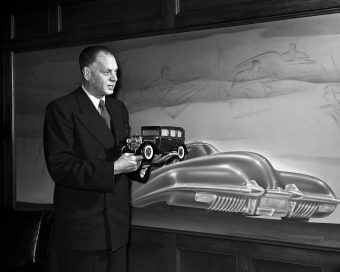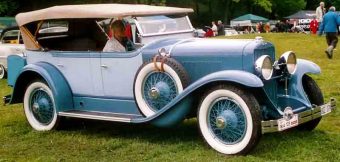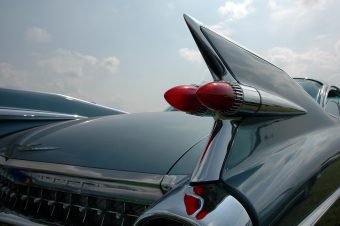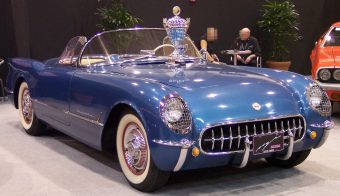The Da Vinci of Detroit
 Harley Earl is considered one of the three most important figures in the history of the American auto industry (Henry Ford and GM head Alfred Sloan are the other two). Yet other than car buffs, few people have heard of him.
Harley Earl is considered one of the three most important figures in the history of the American auto industry (Henry Ford and GM head Alfred Sloan are the other two). Yet other than car buffs, few people have heard of him.
THE HOLLYWOOD KID
In 1925 the General Motors Corporation made plans to begin manufacturing a car called the LaSalle. It would be sold by Cadillac dealerships, but for a price slightly lower than the least expensive Cadillac. Larry Fisher, Cadillac’s general manager, was looking for someone to design it and found his man working in the custom body shop of the Cadillac dealer in Los Angeles: Harley Earl, the son of a Hollywood coach builder who started out building horse-drawn vehicles—actual coaches—before switching to automobile bodies in 1908.
Earl, in his early 30s, had acquired a reputation for building one-of-a-kind autos for rich Hollywood movie stars. His car for cowboy star Tom Mix, for example, was painted with stars emblazoned with Mix’s “TM” logo and had a leather saddle on the roof. His car for comedian Fatty Arbuckle, while much more sedate and elegant, cost Arbuckle an incredible $28,000—at a time when a new Ford Model T sold for less than $300.
QUICK AND DIRTY
What really impressed Fisher about Harley Earl wasn’t so much his cars for the stars as it was his method for designing them: Before he built the final product, Earl made full-sized mock-ups of his vehicles using modeling clay. Unlike working with sheet metal or wood, the common technique of other coach builders, clay was quicker and easier to work with. If Earl wasn’t happy with the shape of a door he’d made, for example, instead of spending hours making a new one out of wood or pounding one out by hand from sheet metal, all he had to do was add a little more clay or scrape a little off, repeating the process as often as necessary until he got exactly the look he wanted. The ease of using clay allowed Earl to be very ambitious and creative in his designs, and just as importantly, it allowed him to think of the car as a single, integrated unit, not a bunch of mechanical components bolted together.
 When Earl arrived in Detroit, he set to work designing four different versions of the La Salle: a coupe, a roadster, a sedan, and a touring car. He borrowed heavily from the Hispano-Suiza, a popular European luxury car of the day, and then implemented what would become a lifelong design principle: Longer, lower cars were more appealing to the eye than shorter cars with high rooflines.
When Earl arrived in Detroit, he set to work designing four different versions of the La Salle: a coupe, a roadster, a sedan, and a touring car. He borrowed heavily from the Hispano-Suiza, a popular European luxury car of the day, and then implemented what would become a lifelong design principle: Longer, lower cars were more appealing to the eye than shorter cars with high rooflines.
SOMETHING TO SEE
Fisher and his boss, GM head Alfred Sloan, were impressed with all four of Earl’s designs and ordered them all into production for the 1927 model year. Those 1927 LaSalles were the very first high-volume, mass-produced cars that had ever been designed by what would become known as a stylist, someone who cared as much about how the car looked as he did about how it ran.
Remember, the auto industry was only a few decades old in 1927, and it had taken all that time just to advance the state of the art to the point where cars were dependable, affordable, and could be mass produced by the hundreds of thousands with no loss of quality. The engineers who had made all of this possible weren’t concerned with what the cars looked like: If buyers wanted a car that looked good on top of everything else, that was what the custom coach builders were for. Cadillac still sold a lot of unfinished cars to these companies—chassis, engine, power train, wheels, radiator, etc., but no body—and coach building firms could spend as much time as they wanted crafting beautiful, luxurious auto bodies by hand.
Those 1927 LaSalles were special cars indeed—they outshone many of the Cadillacs that were supposed to outshine them. Was it their long, low-slung look? Was it their two-tone paint jobs—unheard of in mass-produced cars, which were still mostly available in only dark blue or black? Was it the “Flying Wing” fenders that did it? Those LaSalles flew off the car lots, so impressing GM head Alfred Sloan that he created an entirely new department, the Art and Color Division, to bring GM’s design work in-house, and he brought Harley Earl out from California to run it.
The American auto industry would never be the same again.
MIDEAST MEETS WEST
When Harley Earl arrived in Detroit in the late 1920s, there was no guarantee that his ideas regarding automobile design would prevail. He had the support of Alfred Sloan, the head of General Motors, but the auto industry was still dominated by engineers who were openly hostile to the idea that how a car looked was as important as how well it was built. These engineers were no-nonsense guys and very conservative; one designer said they “dressed like detectives and rarely even took their hats off.” When Harley Earl from Hollywood rolled into town wearing suede shoes with bronze-colored suits and purple shirts, spinning yarns about the car he’d designed with a saddle on the roof, the engineers dismissed him as a “pretty boy” and a “pantywaist” and probably figured he wasn’t going to last very long.
Besides, what was wrong with the way cars looked? They had a certain austere, utilitarian beauty to them, the automotive equivalent of a hammer or an electric drill. Making cars prettier made about as much sense to these engineers as putting makeup on a shotgun.
BRAVE NEW WORLD
But the auto industry was changing, and changing quickly. For most of the previous two decades, automakers had sold most of their cars to people who had never owned one before. Henry Ford had won the battle to sell Americans their very first autos; his giant factories could produce them faster, cheaper, and in greater quantities than any of his competitors could. By 1923 the Model T had a 57 percent share of the U.S. automobile market. Half of all the cars in the world were Fords.
By that time, however, just about everyone in the United States who wanted a car had one. Now the trick for automakers was getting customers to replace the cars they already owned—and had already paid for—with new ones that cost more money. And the auto companies had to get them to do it long before the old car wore out, because if a company had to wait for the old car to die before they sold the owner a new one, it wouldn’t sell enough cars to stay in business.
LIVING IN THE PAST
In the contest to sell Americans their second car, Henry Ford was his own worst enemy. Ford was fixated on the Model T and rightly considered it his greatest creation. Yet over the 19 years that it was sold by the company—the only automobile sold by the company during that time—he refused to significantly upgrade or improve upon the original design. He dismissed as frivolous “knickknacks” such innovations as speedometers, gas gauges, shock absorbers, hydraulic brakes, accelerators on the floorboard instead of on the steering column, and electric starters in place of hand cranks. Ford fought these improvements year after year, often firing the very capable executives who dared to suggest them. (Many of these executives were snapped up by GM.) On those few occasions when Ford finally did incorporate something new into the Model T design, it was usually long after it had become standard equipment on competing cars.
While Henry Ford kept his foot on the brake, Alfred Sloan of GM kept his mashed down on the accelerator. In addition to continually updating his automobile designs, Sloan invented new ways for people to pay for their cars. Where Ford had always insisted on being paid in cash and in full (banks did not yet offer car loans), Sloan created the General Motors Acceptance Corporation (GMAC) to finance the purchase of GM cars. Even though it was impossible for GM to match Ford on the actual price of the car, GMAC financing actually made GM cars more affordable for many buyers. By 1924, the same year that GM became the first company to accept trade-ins, a third of all GM car purchases were financed by GMAC.
For all the emphasis Sloan put into improving the quality of GM automobiles, he also understood that new technology was very costly to develop, took years to bring to market, and often didn’t pan out. But he wanted to maintain the illusion of continual improvement, so in the mid-1920s he introduced the auto industry’s first “annual model change.” From then on, even when the mechanical components of a car remained the same from one year to the next, the car’s appearance would change every year, if only in subtle ways, to keep the public interested in it.
WHAT’S NEW IS OLD…AGAIN
The annual model change would have another effect on consumers: It would cause them to become increasingly dissatisfied with their existing cars from one year to the next, a concept that became known as “planned obsolescence.” (Earl preferred to call it “dynamic obsolescence.”) With any luck, the planned obsolescence would drive car owners into a car dealership a few years early to trade in older cars that had become shabby and dowdy before their time.
Making annual style changes in all the cars sold by GM’s five divisions—Chevrolet, Oakland (later renamed Pontiac), Oldsmobile, Buick, and Cadillac—required a lot of designers, which was why Sloan decided to set up GM’s own in-house Art and Color Division. Those conservatively dressed engineers from the Old School may not have wanted to hear it, but guys like Harley Earl, with their suede shoes, loud suits, and purple shirts, were here to stay…and soon they’d be calling the shots.
REINVENTING THE WHEELS
If there’s one person responsible for the evolution of what we think of as an “antique” car into one that begins to resemble what we think of as a modern car today, it’s Harley Earl. When he arrived at GM in 1927, mass-produced cars still had a sort of thrown-together look, because that was how they were made: Partially assembled cars rolled along a quickly moving assembly line, and autoworkers raced to attach one component after another—a hood over the engine, fenders and a running board on the frame, headlights on the fenders, and so on, until the car was finished. The trunk of the car was exactly that—little more than a steamer trunk attached behind the passenger compartment.
Earl thought that a car should look like a single, unified whole, not just a bunch of components attached to each other, and he began to impart his vision on GM cars. One by one, the distinguishing features of antique cars began to fall away: Boxy shapes and sharp corners gave way to the curves and smooth, flowing lines of Earl’s streamlined bodies. Headlights and fenders were integrated into the bodywork, and so was the trunk—from now on, it would be a trunk in name only. And the spare tire would no longer be bolted to the rear or mounted on one of the running boards (Earl got rid of those, too); it would be hidden inside the trunk.
LOW RIDERS
Earl liked to explain that his purpose from the very beginning was to make cars lower and longer, if for no other reason than he thought oblong shapes were more pleasing to the eye than the short, boxy cars that were common when he was starting out. Just as he had with the 1927 LaSalle, Earl began lengthening the wheelbase (the distance between the front and rear wheels) of the cars he worked on. This created enough space between them to lower the passenger compartment so that the occupants were cradled more or less between the front and rear wheels instead of on top of them, which is where people had ridden since the horse-and-wagon days. In addition to making the car look nicer, lowering the passenger compartment made for a smoother ride.
WHAT A CONCEPT
The changes that Harley Earl brought to automobiles were dizzying, especially to an auto-buying public that had seen very little change in automobiles since their invention. But Earl was careful to introduce his changes gradually, never making more in a year than he thought customers could adjust to. He had an exquisite sense of just how much he could get away with without alienating potential buyers, and he fine-tuned his judgment by producing the auto industry’s first concept cars, which he used to preview his designs with the public and test whether they went too far.
THE HIDEOUT
Earl didn’t spend a lot of time at the drafting table himself; instead, he oversaw a network of 17 different design studios, including one for each division of GM and 12 other special studios that made up the Art & Color Division. (Earl renamed it the Style Section in 1937.) He did his thinking in a hidden office he called the “Hatchery,” which had blacked-out windows, no telephone, and a phony name on the door so that no one would disturb him there. He came up with the overall strategic vision for his cars, and then worked with the different design studios to bring his ideas to life. An excellent critic of other people’s work (which didn’t always make him the easiest guy to work with), he pushed and prodded and preached and praised until the designers working under him brought his dreams to life, exactly as he’d envisioned them.
In the process, Earl oversaw the design of virtually every Chevrolet, Oakland (renamed Pontiac in 1932), Oldsmobile, Buick, and Cadillac designed between 1928 and 1959. The 1949 Cadillac Coupe de Ville, Cadillac’s first pillarless hardtop, with no roof support pillar behind the front doors to obstruct the driver’s vision. The 1953 Cadillac Eldorado and Oldsmobile Fiesta, with the first wraparound windshields. The 1959 Chevy El Camino, General Motors’ combination sedan and pickup truck (hey, nobody’s perfect), produced in response to the successful Ford Ranchero. All these GM cars, and all the others, too—Harley Earl styled each one.
DREAM MACHINES
A true son of Hollywood, Earl thought of his cars as pieces of entertainment. He wanted people to derive pleasure by looking at them, and he wanted driving them to be a dream. “I try to design a car so that every time you get in it, it’s a relief—you have a little vacation for a while,” he liked to say.
 For all the changes Earl made to his cars, in his early years at GM they still managed to be shaped like cars. But in the 1940s and ’50s, his designs became ever bolder, as he drew obvious inspiration from locomotives, airplanes, torpedoes, and eventually even atomic missiles and rocket ships. Airplanes and rockets have tail-fins because they need them—they’d crash without them. The tail-fins (inspired by the Lockheed P-38 Lightning fighter plane) that Earl introduced to automobiles, beginning with the 1948 Cadillac, served no functional purpose at all. Earl couldn’t give GM customers a real jet plane or rocket ship to the moon, but he could make them feel like they were flying whenever they got behind the wheel of one of his cars.
For all the changes Earl made to his cars, in his early years at GM they still managed to be shaped like cars. But in the 1940s and ’50s, his designs became ever bolder, as he drew obvious inspiration from locomotives, airplanes, torpedoes, and eventually even atomic missiles and rocket ships. Airplanes and rockets have tail-fins because they need them—they’d crash without them. The tail-fins (inspired by the Lockheed P-38 Lightning fighter plane) that Earl introduced to automobiles, beginning with the 1948 Cadillac, served no functional purpose at all. Earl couldn’t give GM customers a real jet plane or rocket ship to the moon, but he could make them feel like they were flying whenever they got behind the wheel of one of his cars.
Thanks in large part to Earl’s influence, the American automobile was no longer just a means of transportation. More than ever, it became a status symbol and an object of desire. People didn’t buy cars just because they needed them; they bought them because they had to have them, a feeling that lasted until they traded it in on the next model (which they also absolutely had to have).
MR. DETROIT, MR. WORLD
Earl worked for GM for 30 years, from 1927 until his retirement in 1958 after overseeing the development of the 1959 models. If your dream car was built by GM in that period—a 1957 Chevy Bel Air convertible, perhaps—you have Earl to thank for it. If your dream car hails from the same era but was built by Ford or Chrysler, or even MG or Citroën, you may still have him to thank for it because his designs proved so successful that virtually every other car company in the world adopted his methods, all the way down to the clay mock-ups he pioneered while he was still building cars for Hollywood film stars. Many of the best-looking cars produced by other automakers were designed by Earl-trained stylists who were lured away from GM.
Few of these designers were able to repeat their mentor’s success, and without GM’s enormous profits, few of the smaller American auto companies, including Kaiser-Frazer, Hudson, and Nash, could keep up with the pace of annual model changes. They either merged with other struggling companies, or went under. Given GM’s problems in recent years, it’s easy to forget that by the early 1960s more than half of all cars sold in the United States were made by GM, with Ford and Chrysler divvying up the rest. In those days, GM’s biggest fear was being broken up by the federal government for being a monopoly—in that sense, the company was actually selling too many cars for its own good.
TOO LITTLE, TOO LATE
On Earl’s watch, GM cars became ever bigger, ever longer, ever heavier, ever chrome-ier, and yet toward the end of his career even he apparently began to realize that being bigger, longer, and heavier had its limits. After a trip to a sports car race in 1951, Earl came away so impressed with the enthusiasm that the drivers had for their autos that he talked GM into building the company’s first-ever two-seater sports car—the 1953 Corvette, which was substantially smaller than most other GM cars made that year.
By the late 1950s, the story goes, Earl couldn’t help but notice as he walked from the parking lot into his office that many of his young designers had taken to driving smaller cars—lots of Corvettes, of course, but also Porsches, Triumphs, Fiats, MGs, and even Volkswagen Beetles, whose most appealing feature to VW buyers was that they weren’t anything at all like the cars being sold by Detroit. Small cars were likely to play a big role in the future, Earl thought, and as he approached retirement he pushed GM to begin building more small cars so that fans of these little imports would also have a range of domestic cars to choose from.
 Earl succeeded in bringing the Corvette into production, but his theory that smaller cars were the wave of the future did not win much acceptance at GM. After he retired in 1958, his successors continued grinding out one gas-guzzling land yacht after another, even as the Ford Edsel, described by one historian as the “Titanic of Automobiles,” flopped in 1957 (taking $250 million of Ford’s money with it) and sales of the Volkswagen Beetle—and other small cars like it—continued to climb year after year.
Earl succeeded in bringing the Corvette into production, but his theory that smaller cars were the wave of the future did not win much acceptance at GM. After he retired in 1958, his successors continued grinding out one gas-guzzling land yacht after another, even as the Ford Edsel, described by one historian as the “Titanic of Automobiles,” flopped in 1957 (taking $250 million of Ford’s money with it) and sales of the Volkswagen Beetle—and other small cars like it—continued to climb year after year.
END OF THE ROAD
GM paid (and continues to pay) a heavy price for ignoring Earl’s advice and not moving into the small-car business in time to compete with the Japanese automakers. But perhaps the most enduring testimony to Harley Earl’s brilliance as a designer is that more than 50 years after he left the company (he died from a stroke in 1969 at the age of 75), his cars are still considered the high-water mark of American automobile design. GM has spent 50 years looking for another designer who could make its buyers feel the same way about brand-new Saturns, Chevys, Pontiacs, Buicks, and Cadillacs as they do about the cars designed during the Earl era. And they haven’t found one yet.
 This article is reprinted with permission from Uncle John’s Unsinkable Bathroom Reader. Uncle John and his crack staff of writers prove that after more than two decades in the business, they’re still at the top of their game. Who else but Uncle John could tell you about the tapeworm diet, 44 things to do with a coconut, and the history of the Comstock Lode? Uncle John rules the world of information and humor, so get ready to be thoroughly entertained.
This article is reprinted with permission from Uncle John’s Unsinkable Bathroom Reader. Uncle John and his crack staff of writers prove that after more than two decades in the business, they’re still at the top of their game. Who else but Uncle John could tell you about the tapeworm diet, 44 things to do with a coconut, and the history of the Comstock Lode? Uncle John rules the world of information and humor, so get ready to be thoroughly entertained.
Since 1987, the Bathroom Readers’ Institute has led the movement to stand up for those who sit down and read in the bathroom (and everywhere else for that matter). With more than 15 million books in print, the Uncle John’s Bathroom Reader series is the longest-running, most popular series of its kind in the world.
If you like Today I Found Out, I guarantee you’ll love the Bathroom Reader Institute’s books, so check them out!
| Share the Knowledge! |
|




